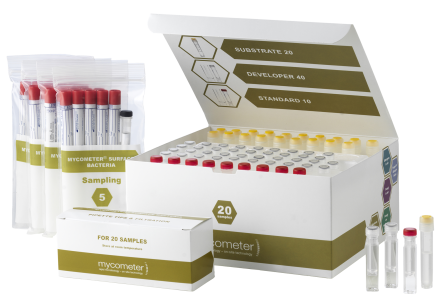Sampling kit for Mycometer® surface Bacteria Sterile swab Wetting solution Template (9cm2)
Collecting a sample
Break the seal on the sterile swab container by twisting the red cap.
The cotton swab is then wetted in the sterile saline contained in the tube with the black cap. (Do not use the green capped wetting solution from the Mycometer® surface Bacteria test!)
Apply the self-adhesive template to the surface to be sampled.
Firmly grip the wooden swab handle, keeping your fingers at least one inch from the cotton swab.
Thoroughly clean the surface as well as possible by rubbing the area inside the template.
The swab should be rotated in order to use as much of the cotton as possible. Keep a low angel between the swab and surface.
Return the swab into the container until analysis. Samples should be analysed within 24 hours of collection.
Other things to consider about sampling
When sampling for bacteria often there is no visual sign, such as discoloration, as is frequently seen when sampling for mould. It is, therefore, not always obvious where to sample. In our experience Bacteria are often scattered unevenly on a surface. It is recommended to take a minimum of three samples from the surface in order to have a high probability of discovering a bacterial contamination.







